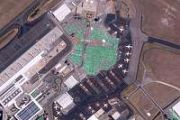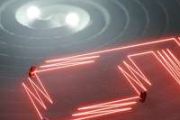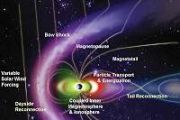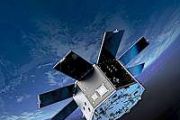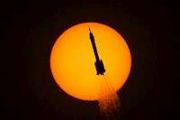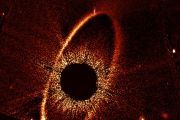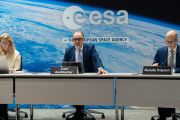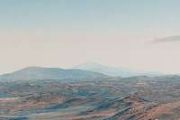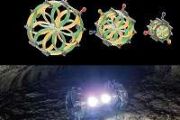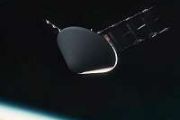
Copernical Team
Debris from NASA's DART Mission Could Potentially Reach Earth and Mars
 NASA's Double Asteroid Redirect Test (DART) mission, which struck the asteroid Dimorphos in 2022, has not only altered the asteroid's orbit but has also created a plume of debris that may eventually reach both Earth and Mars, according to new simulations. The debris, although harmless, could potentially be observed as meteors.
On September 26, 2022, NASA's DART spacecraft, weighing approxi
NASA's Double Asteroid Redirect Test (DART) mission, which struck the asteroid Dimorphos in 2022, has not only altered the asteroid's orbit but has also created a plume of debris that may eventually reach both Earth and Mars, according to new simulations. The debris, although harmless, could potentially be observed as meteors.
On September 26, 2022, NASA's DART spacecraft, weighing approxi National lab takes its radiation expertise to space

An experiment designed to answer questions about the radiation environment for manned space missions was launched from Kennedy Space Center today.
For the five-day mission, experiments from the Department of Energy's Pacific Northwest National Laboratory and several other institutions will circle the Earth 435 miles above—nearly twice as high as the International Space Station. Before settling in at that altitude, Polaris Dawn will reach 870 miles, the highest that any person has been since NASA's Apollo program several decades ago.
Earth scientists take flight, set sail to verify PACE satellite data
 From sea to sky to orbit, a range of vantage points allow NASA Earth scientists to collect different types of data to better understand our changing planet. Collecting them together, at the same place and the same time, is an important step used to verify the accuracy of satellite data.
NASA's Plankton, Aerosol, Cloud, ocean Ecosystem (PACE) satellite launched in February 2024 and is colle
From sea to sky to orbit, a range of vantage points allow NASA Earth scientists to collect different types of data to better understand our changing planet. Collecting them together, at the same place and the same time, is an important step used to verify the accuracy of satellite data.
NASA's Plankton, Aerosol, Cloud, ocean Ecosystem (PACE) satellite launched in February 2024 and is colle What's it Like to Spacewalk?
 Spacewalks occur in the vacuum of deep space, but astronauts are tethered to their spacecraft if they exit an orbiting space station, space module, or spacecraft. Inside a spaceship, conditions are well suited to humans. Outside, in space, it's an entirely different story. The frigid vacuum of space presents deadly risks.
Spacewalks occur in the vacuum of deep space, but astronauts are tethered to their spacecraft if they exit an orbiting space station, space module, or spacecraft. Inside a spaceship, conditions are well suited to humans. Outside, in space, it's an entirely different story. The frigid vacuum of space presents deadly risks. Private astronauts on daring trek ahead of historic spacewalk
 A private crew set out on an audacious orbital expedition Tuesday, journeying deeper into the cosmos than any humans in half a century as they prepare for the first ever spacewalk by non-professional astronauts.
The SpaceX Polaris Dawn mission, led by Shift4 Payments CEO Jared Isaacman, launched from the Kennedy Space Center in Florida and should by the end of its first day attain a peak alt
A private crew set out on an audacious orbital expedition Tuesday, journeying deeper into the cosmos than any humans in half a century as they prepare for the first ever spacewalk by non-professional astronauts.
The SpaceX Polaris Dawn mission, led by Shift4 Payments CEO Jared Isaacman, launched from the Kennedy Space Center in Florida and should by the end of its first day attain a peak alt SpaceX launches all-civilian crew for first private spacewalk

SpaceX launched its historic Polaris Dawn mission on Tuesday—an audacious orbital expedition that will catapult civilians into a high-radiation region of space and see them attempt the first-ever spacewalk by non-professional astronauts.
Led by Shift4 Payments CEO Jared Isaacman, the four-member crew aims to journey farther into the cosmos than any other manned mission in more than half a century, since the end of the Apollo era.
On the mission's first day, they will soar to a peak altitude of 870 miles (1,400 kilometers) before returning into a lower orbit.
"Dragon will travel repeatedly through the orbital altitudes of over 10 thousand satellites and bits of space debris," SpaceX founder CEO Elon Musk wrote on X.
Using a space elevator to get resources from Ceres

Here at UT, we've had several stories that describe the concept of a space elevator. They are designed to make it easier to get objects off Earth and into space. That, so far, has proven technically or economically infeasible, as no material is strong enough to support the structure passively, and it's too energy-intensive to support it actively.
However, it could be more viable on other worlds, such as the moon. But what about worlds farther afield? A student team from the University of Colorado at Colorado Springs looked at the use case of a space elevator on Ceres and found that it could be done with existing technology. The findings are published in the journal 2024 Regional Student Conferences.
Before we discuss why anyone would want to put a space elevator on Ceres, let's first examine the technologies that would make it possible. Every space elevator design has three different components: an anchor, a tether, and a counterweight.
Who is on SpaceX's historic private spacewalk mission?

Four US civilians are set to attempt the first-ever private spacewalk on Thursday—a risky endeavor usually reserved for trained astronauts from government agencies.
The ambitious mission, dubbed Polaris Dawn, is being carried out on a SpaceX capsule that launched early Tuesday from Florida.
Who are the select few to pioneer this new chapter of space exploration?
Jared Isaacman, billionaire
The driving force behind the mission is Jared Isaacman, a billionaire who serves as mission commander.
The 41-year-old American from Pennsylvania is the CEO of the digital finance company Shift4 Payments, which he founded in his family's basement when he was only 16.
Isaacman is a seasoned pilot who is qualified to fly military aircraft and holds several world records.
He had previously gone into space in 2021 as part of another SpaceX mission he chartered, Inspiration4, which was the first orbital spacecraft to feature no professional astronauts.
SpaceX launches billionaire to conduct the first private spacewalk

A daredevil billionaire rocketed back into orbit Tuesday, aiming to perform the first private spacewalk and venture farther than anyone since NASA's Apollo moonshots.
Unlike his previous chartered flight, tech entrepreneur Jared Isaacman shared the cost with SpaceX this time around, which included developing and testing brand new spacesuits to see how they'll hold up in the harsh vacuum.
If all goes as planned, it will be the first time private citizens conduct a spacewalk, but they won't venture away from the capsule. Considered one of the riskiest parts of spaceflight, spacewalks have been the sole realm of professional astronauts since the former Soviet Union popped open the hatch in 1965, closely followed by the U.S.
Space Team Europe for Vega: final liftoff
 Video:
00:03:13
Video:
00:03:13
Interviews with personnel that worked on the last Vega rocket, flight VV24, with Sentinel-2C onboard.
The third Copernicus Sentinel-2 satellite launched from Europe’s Spaceport in French Guiana aboard the final Vega rocket on 5 September at 03:50 CEST (4 September 22:50 local time).
After a successful launch, Sentinel-2C separated from its Vega rocket at approximately 04:48 CEST. Around 14 minutes later, at 05:02 CEST, ESA’s ESOC mission operations centre in Darmstadt, Germany, received the all-important first signals from the satellite indicating that it had safely arrived in orbit.
Giovanna Manca, Vega launch complex operations manager for Avio, Fulvio Spaziani Brunella, Site manager for Avio,


